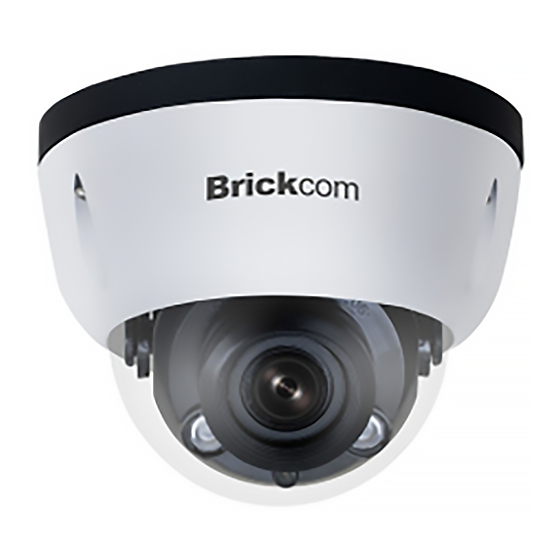
Advertisement
Quick Links
Advertisement

Subscribe to Our Youtube Channel
Summary of Contents for Brickcom VD-200Np-S
- Page 1 Megapixel Network Camera Easy Installation Guide VD-200Np-S...
-
Page 2: Safety Instruction
I. Preface Thank you for purchasing our product. If there is any question, please do not hesitate to contact us. These instructions are intended to ensure that the user can use the product correctly to avoid danger or property loss. Please read this Guide carefully before using the product, and keep it properly for future reference. - Page 3 3. Daily Maintenance Do not touch the heat component of the device directly to avoid empyrosis. When the lens is contaminated by dust or grease, use cotton cloth or lens clean cloth to wipe it off. When it is hard to clean, dip some lens cleanser and wipe gently and rotate outward from the middle until it is clean. Never apply any organic solvent with ethanol or benzene to clean the lens and housing.
-
Page 4: Appearance And Interface
III. Appearance and Interface Dimensions: 3-∅5 ∅111 84.77 Unit: mm Components: Part Name Semi-dome Movement module Lens-adjusting screw Base Side wiring hole... - Page 5 Buttcock line: Table 1 Wiring Interface Interface Name Interface Function Including alarm in / out, audio in / out, RS-485 serial port and etc. User cable group Local video output composite video signal, BNC port Video output Power supply Connect to power supply of DC12V Network Connect to network access devices like a switch Table 2 Cable Group Interface...
- Page 6 IV. DC12V Wire Diameter VS. Transmission Distance The recommended max transmission distance when the wire diameter is certain and the DC12V voltage loss rate is less than 10% (For DC12V powered devices, the maximum allowed voltage loss rate is 10%. All the wires in the following table are cooper wires, whose electrical resistivity is ρ...
-
Page 7: Installation
V. Installation The camera supports ceiling mount, wall mount, pendent mount and wall bracket mount. As pendent mount and wall bracket mount need brackets but the device itself does not contain brackets, please contact your supplier or customer service personnel to purchase. Camera weight: 0.6kg (net) Ceiling mount Wall mount... - Page 8 1. Take down the dome housing. Use a screw driver to screw off the 3 cross recessed pan tamper screws and take down the dome housing. Note: Do not put the transparent dome housing on the ground when taking it down to avoid scratching. Prevent scratching the internal of the dome housing with the screw driver during operation;...
- Page 9 4. Drill holes. Drill 3 basic holes with plastic expansion screw bolts at the 3 "cross" hole marks on the sticker and insert the 3 expansion screw bolts thoroughly into the holes. [Note] If routing the cables from the top of the mounting surface, a cable outlet hole is also needed at the part of "Cable Hole"...
- Page 10 6. Adjust lens surveillance direction. Loosen the lens angle-adjusting screw, rotate the dome manually and the lens will rotate in pan and tilt directions. Rotate the rotating part at the back of the lens. When the lens rotates till ±90°, set the mode as corridor mode while 0° as common mode. It's inadvisable to rotate too hard during adjustment to avoid damage to the parts.
- Page 11 Pendent Mount: Though the pendent bracket is different with the wall bracket, their installation method is quite similar. Now take the pendent bracket as an example to illustrate the installation steps, which is also a reference for wall bracket mount. When choosing pendent or wall bracket mount, please make sure that the mounting wall or ceiling is thick and solid enough for fixing tapping screws and meanwhile strong enough for bearing the total weight of the device and the bracket.
- Page 12 [Note] The outer diameter of the drill should match with that of the expansion screw bolt and the hole deepness match the screw bolt length. 2. Take down the dome housing. Use a screw driver to screw off the 3 cross recessed pan tamper screws and take down the dome housing.
- Page 13 5. Fix bracket. Align the 4 screw holes on the bracket base to the 4 expansion screw bolts on the mounting surface, tighten the 4 tapping screws into the expansion screw bolts and fix the pendent bracket onto the mounting surface. 6.
- Page 14 VI. Login to Client 1. Minimum configurations and system requirements: Processor: 3.3 GHz CORE®i3 series or other equivalent processors Ÿ RAM Memory: 4GB or above Ÿ Operating System: Windows XP or newer version Ÿ Browser: IE7.0 and newer version, Firefox, Google Chrome (41 and lower) Ÿ...
- Page 15 3. Modify device IP address Click “Modify Params” and set the network parameters. When configuring a static IP for the camera, please check “Custom device address (Close DHCP)” and fill the Ethernet parameter. During the modification, the user name (admin) and the password set before activation should be entered. After configuration, the camera will reboot automatically.
- Page 16 2) After login, download and install the plug-in. Close browser during installation. 3) Re-login to the web client and view live video directly. [Note]: Interface of different models may differ. Please subject it to the actual product. Please refer to the Help file for detailed explanation.
- Page 17 V1 20190716...


Need help?
Do you have a question about the VD-200Np-S and is the answer not in the manual?
Questions and answers